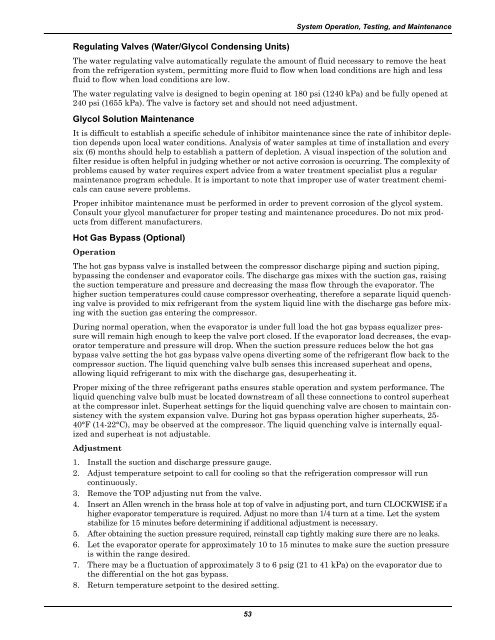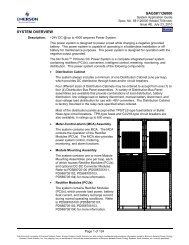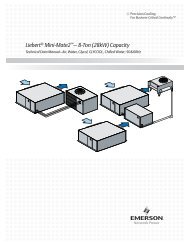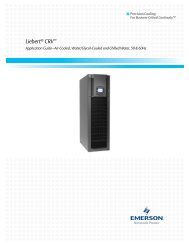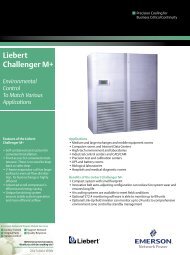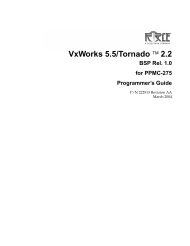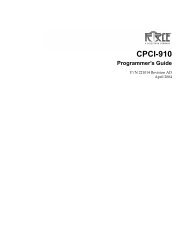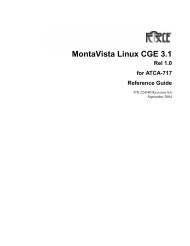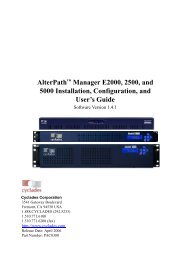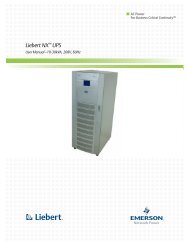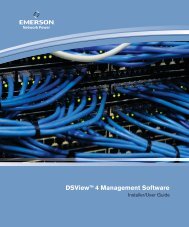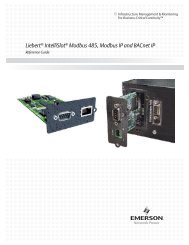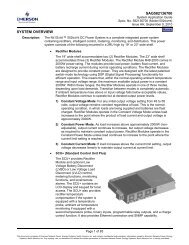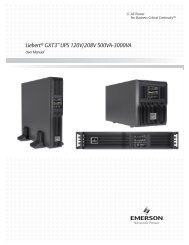Liebert Mini-Mate2, 8 Ton - Emerson Network Power
Liebert Mini-Mate2, 8 Ton - Emerson Network Power
Liebert Mini-Mate2, 8 Ton - Emerson Network Power
You also want an ePaper? Increase the reach of your titles
YUMPU automatically turns print PDFs into web optimized ePapers that Google loves.
Regulating Valves (Water/Glycol Condensing Units)<br />
53<br />
System Operation, Testing, and Maintenance<br />
The water regulating valve automatically regulate the amount of fluid necessary to remove the heat<br />
from the refrigeration system, permitting more fluid to flow when load conditions are high and less<br />
fluid to flow when load conditions are low.<br />
The water regulating valve is designed to begin opening at 180 psi (1240 kPa) and be fully opened at<br />
240 psi (1655 kPa). The valve is factory set and should not need adjustment.<br />
Glycol Solution Maintenance<br />
It is difficult to establish a specific schedule of inhibitor maintenance since the rate of inhibitor depletion<br />
depends upon local water conditions. Analysis of water samples at time of installation and every<br />
six (6) months should help to establish a pattern of depletion. A visual inspection of the solution and<br />
filter residue is often helpful in judging whether or not active corrosion is occurring. The complexity of<br />
problems caused by water requires expert advice from a water treatment specialist plus a regular<br />
maintenance program schedule. It is important to note that improper use of water treatment chemicals<br />
can cause severe problems.<br />
Proper inhibitor maintenance must be performed in order to prevent corrosion of the glycol system.<br />
Consult your glycol manufacturer for proper testing and maintenance procedures. Do not mix products<br />
from different manufacturers.<br />
Hot Gas Bypass (Optional)<br />
Operation<br />
The hot gas bypass valve is installed between the compressor discharge piping and suction piping,<br />
bypassing the condenser and evaporator coils. The discharge gas mixes with the suction gas, raising<br />
the suction temperature and pressure and decreasing the mass flow through the evaporator. The<br />
higher suction temperatures could cause compressor overheating, therefore a separate liquid quenching<br />
valve is provided to mix refrigerant from the system liquid line with the discharge gas before mixing<br />
with the suction gas entering the compressor.<br />
During normal operation, when the evaporator is under full load the hot gas bypass equalizer pressure<br />
will remain high enough to keep the valve port closed. If the evaporator load decreases, the evaporator<br />
temperature and pressure will drop. When the suction pressure reduces below the hot gas<br />
bypass valve setting the hot gas bypass valve opens diverting some of the refrigerant flow back to the<br />
compressor suction. The liquid quenching valve bulb senses this increased superheat and opens,<br />
allowing liquid refrigerant to mix with the discharge gas, desuperheating it.<br />
Proper mixing of the three refrigerant paths ensures stable operation and system performance. The<br />
liquid quenching valve bulb must be located downstream of all these connections to control superheat<br />
at the compressor inlet. Superheat settings for the liquid quenching valve are chosen to maintain consistency<br />
with the system expansion valve. During hot gas bypass operation higher superheats, 25-<br />
40°F (14-22°C), may be observed at the compressor. The liquid quenching valve is internally equalized<br />
and superheat is not adjustable.<br />
Adjustment<br />
1. Install the suction and discharge pressure gauge.<br />
2. Adjust temperature setpoint to call for cooling so that the refrigeration compressor will run<br />
continuously.<br />
3. Remove the TOP adjusting nut from the valve.<br />
4. Insert an Allen wrench in the brass hole at top of valve in adjusting port, and turn CLOCKWISE if a<br />
higher evaporator temperature is required. Adjust no more than 1/4 turn at a time. Let the system<br />
stabilize for 15 minutes before determining if additional adjustment is necessary.<br />
5. After obtaining the suction pressure required, reinstall cap tightly making sure there are no leaks.<br />
6. Let the evaporator operate for approximately 10 to 15 minutes to make sure the suction pressure<br />
is within the range desired.<br />
7. There may be a fluctuation of approximately 3 to 6 psig (21 to 41 kPa) on the evaporator due to<br />
the differential on the hot gas bypass.<br />
8. Return temperature setpoint to the desired setting.


